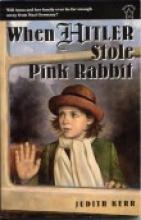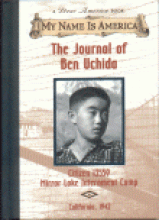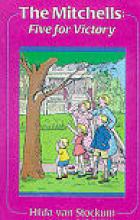Life during World War II
When Hitler Stole Pink Rabbit
Subject(s):
Setting:
Grade / Age level:
Review:
A well-written and engaging account, based on the author's experiences of a young (non-religious) Jewish girl and her family who escape from Germany in the 1930s and live for a time in Switzerland and then France before finally moving on to England. We see the escalation of Hitler's Germany from somewhat of a distance and the struggles of a displaced family trying to stay out of Hitler's reach (the father was a well-known writer who eventually has a price put on his head by Hitler). A worthwhile read, probably of more interest to girls than boys, and suitable for independent reading for mid grade-school and up.
Reviewed by:
First reviewed:
1-12-01
The Journal of Ben Uchida
Subject(s):
Grade / Age level:
Review:
This is a fictitious diary of a 12 year old boy in a Japanese internment camp in California during World War II. (The diary covers the bombing of Pearl Harbor - Dec. 7 1941 thru parts of 1943). The diary is based on letters from Internment camp survivors and other actual events from the time period.
The story helps the reader to understand certain truths about the camps and the consequences of having such camps;
Many of the prisoners, particularly the children were every bit like other Americans in their loyalties, interests and lifestyles and didn't identify with Japan at all.
The camps were a very difficult place to raise children and tended to cause a decline in morals and traditions among the people. A few examples: because the living quarters are so small (one room usually divided with a blanket to accomodate two families), the children roam fairly freely about the camp, allowing for such situations as this: the main character and another boy sneak off to try to see some "naked girls" changing for a play (they are unsuccessful). As far as traditions go, it is very sad to learn that the very traditional Japanese mothers and grandmothers are forced to wear pants because the dust and wind make dresses unmanageable.
The overall injustice of the situation is clearly portrayed as well. Before they leave for the camps, families are forced to sell nearly all of their belongings at ridiculous prices (the author does also introduce us to some kind neighbors and friends who help these families in various ways, such as storing furniture for them). Some of the fathers are taken away for a time to a separate camp because the government thinks they might have specific connections with the Japanese.
After I read the book, I was at first struck that it was very depressing. All of the bad things that happen are not alleviated by a hope in God or even a hero figure on a natural level. Ben Uchida is merely recording the way things are, rather than reflecting on them (with the exception of becoming somewhat cynical). It finally struck me that what the author has done is portray many of the major aspects of the hardships of the internment camp through the eyes of one boy and have all of the different sorts of problems occur within his close circle of friends. I believe that this is somewhat unrealistic and that the book should be read by children old enough to understand this concept. Other than that (and the objectionable incident mentioned above) it really does give the reader a sense of the significance of this terrible event in American history which - even in the politically correct climate of modern America - is largely ignored. The Historical Note section (17 pages) is quite interesting. It includes some factual information about the camps, a number of black and white photos, and a brief history of the treatment of Chinese and Japanese in America (and particularly the discriminatory laws aimed against them over the years). It is also interesting that Franklin Roosevelt (who is so admired by "the left" today) is quite fairly criticized for committing such a crime against American citizens (by Executive Order) and it is interesting that it was Ronald Reagan who attempted to make some sort of retribution (however inadequate) to the Internment Camp survivors.
The story helps the reader to understand certain truths about the camps and the consequences of having such camps;
Many of the prisoners, particularly the children were every bit like other Americans in their loyalties, interests and lifestyles and didn't identify with Japan at all.
The camps were a very difficult place to raise children and tended to cause a decline in morals and traditions among the people. A few examples: because the living quarters are so small (one room usually divided with a blanket to accomodate two families), the children roam fairly freely about the camp, allowing for such situations as this: the main character and another boy sneak off to try to see some "naked girls" changing for a play (they are unsuccessful). As far as traditions go, it is very sad to learn that the very traditional Japanese mothers and grandmothers are forced to wear pants because the dust and wind make dresses unmanageable.
The overall injustice of the situation is clearly portrayed as well. Before they leave for the camps, families are forced to sell nearly all of their belongings at ridiculous prices (the author does also introduce us to some kind neighbors and friends who help these families in various ways, such as storing furniture for them). Some of the fathers are taken away for a time to a separate camp because the government thinks they might have specific connections with the Japanese.
After I read the book, I was at first struck that it was very depressing. All of the bad things that happen are not alleviated by a hope in God or even a hero figure on a natural level. Ben Uchida is merely recording the way things are, rather than reflecting on them (with the exception of becoming somewhat cynical). It finally struck me that what the author has done is portray many of the major aspects of the hardships of the internment camp through the eyes of one boy and have all of the different sorts of problems occur within his close circle of friends. I believe that this is somewhat unrealistic and that the book should be read by children old enough to understand this concept. Other than that (and the objectionable incident mentioned above) it really does give the reader a sense of the significance of this terrible event in American history which - even in the politically correct climate of modern America - is largely ignored. The Historical Note section (17 pages) is quite interesting. It includes some factual information about the camps, a number of black and white photos, and a brief history of the treatment of Chinese and Japanese in America (and particularly the discriminatory laws aimed against them over the years). It is also interesting that Franklin Roosevelt (who is so admired by "the left" today) is quite fairly criticized for committing such a crime against American citizens (by Executive Order) and it is interesting that it was Ronald Reagan who attempted to make some sort of retribution (however inadequate) to the Internment Camp survivors.
Reviewed by:
First reviewed:
6-21-2000
The Mitchells: Five for Victory
Subject(s):
Grade / Age level:
Review:
This is a charming and thoughtful story of an American family of five children during World War II (based on Hilda Van Stockum's own family) whose father is away at war. The family is very real with plenty of worries and troubles...but they manage to find joy with each other. For independent reading, it could be one your children's first full-length chapter books.Wit and wisdom make it a can't miss for adults as well (a perfect read-aloud). This has been a favorite with our family (for children as young as four or five) for many years.
Washington D.C. is an exciting place to grow up and the children are enchanted with pets, clubs and a mysterious girl who has just moved in down the street. Mother's attempts to take in boarders and a visit from Uncle Jim and "Mr. Jenkins" keep them busy while Father is away. Pets and babies are particularly memorable characters.
There is an aspect of the story that might be troubling for young children sensitive about adoption. A neighbor who considers adopting a war refugee decides not to because the child doesn't get along with the lady's son. The fate of adopted children is discussed rather carelessly by this lady (in terms of "well, my son has to come first") and the mother of the Mitchells doesn't have any good comebacks to resolve the issue. The story resolves nicely, however, as the girl ends up finding her grandfather, but this segment might need a little explanation. My sister-in-law (who has two adopted children) found the issue troubling and put the book aside until her children were older.
Washington D.C. is an exciting place to grow up and the children are enchanted with pets, clubs and a mysterious girl who has just moved in down the street. Mother's attempts to take in boarders and a visit from Uncle Jim and "Mr. Jenkins" keep them busy while Father is away. Pets and babies are particularly memorable characters.
There is an aspect of the story that might be troubling for young children sensitive about adoption. A neighbor who considers adopting a war refugee decides not to because the child doesn't get along with the lady's son. The fate of adopted children is discussed rather carelessly by this lady (in terms of "well, my son has to come first") and the mother of the Mitchells doesn't have any good comebacks to resolve the issue. The story resolves nicely, however, as the girl ends up finding her grandfather, but this segment might need a little explanation. My sister-in-law (who has two adopted children) found the issue troubling and put the book aside until her children were older.
Perspective:
Catholic
Reviewed by:
First reviewed:
12-12-05



